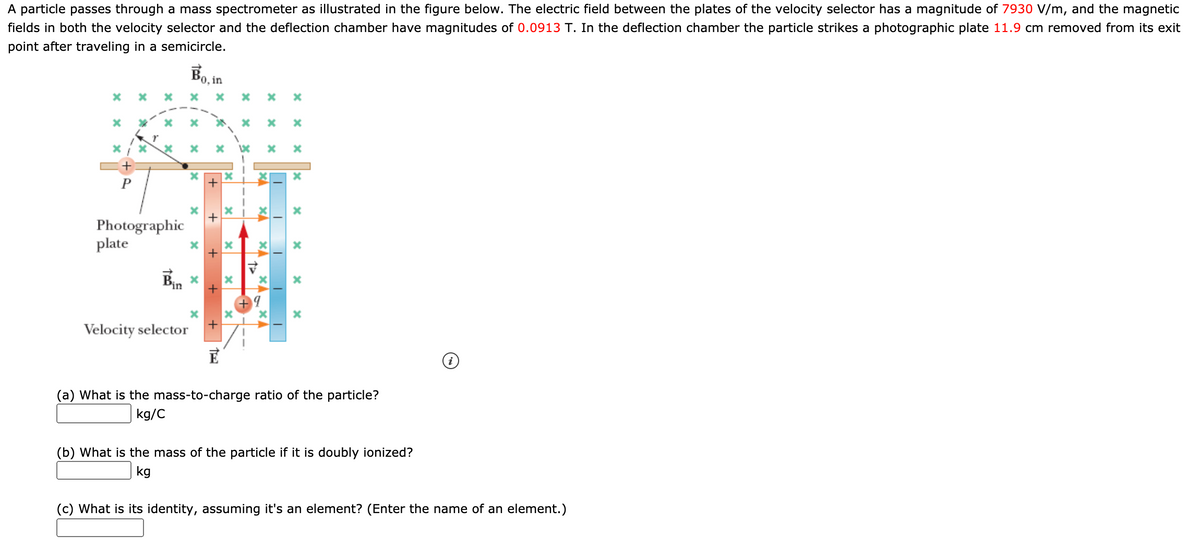A particle passes through a mass spectrometer as illustrated in the figure below. The electric field between the plates of the velocity selector has a magnitude of 7930 V/m, and the magnetic fields in both the velocity selector and the deflection chamber have magnitudes of 0.0913 T. In the deflection chamber the particle strikes a photographic plate 11.9 cm removed from its exit point after traveling in a semicircle. Bo in Photographic plate B.. x Velocity selector (a) What is the mass-to-charge ratio of the particle? kg/C (b) What is the mass of the particle if it is doubly ionized? kg
A particle passes through a mass spectrometer as illustrated in the figure below. The electric field between the plates of the velocity selector has a magnitude of 7930 V/m, and the magnetic fields in both the velocity selector and the deflection chamber have magnitudes of 0.0913 T. In the deflection chamber the particle strikes a photographic plate 11.9 cm removed from its exit point after traveling in a semicircle. Bo in Photographic plate B.. x Velocity selector (a) What is the mass-to-charge ratio of the particle? kg/C (b) What is the mass of the particle if it is doubly ionized? kg
Principles of Physics: A Calculus-Based Text
5th Edition
ISBN:9781133104261
Author:Raymond A. Serway, John W. Jewett
Publisher:Raymond A. Serway, John W. Jewett
Chapter22: Magnetic Forces And Magnetic Fields
Section: Chapter Questions
Problem 15P: Consider the mass spectrometer shown schematically in Active Figure 22.12. The magnitude of the...
Related questions
Question

Transcribed Image Text:A particle passes through a mass spectrometer as illustrated in the figure below. The electric field between the plates of the velocity selector has a magnitude of 7930 V/m, and the magnetic
fields in both the velocity selector and the deflection chamber have magnitudes of 0.0913 T. In the deflection chamber the particle strikes a photographic plate 11.9 cm removed from its exit
point after traveling in a semicircle.
'0, in
Photographic
plate
Bin x
+
Velocity selector
E
(a) What is the mass-to-charge ratio of the particle?
kg/C
(b) What is the mass of the particle if it is doubly ionized?
kg
(c) What is its identity, assuming it's an element? (Enter the name of an element.)
X-
1x
+
Expert Solution
This question has been solved!
Explore an expertly crafted, step-by-step solution for a thorough understanding of key concepts.
This is a popular solution!
Trending now
This is a popular solution!
Step by step
Solved in 2 steps with 2 images

Knowledge Booster
Learn more about
Need a deep-dive on the concept behind this application? Look no further. Learn more about this topic, physics and related others by exploring similar questions and additional content below.Recommended textbooks for you

Principles of Physics: A Calculus-Based Text
Physics
ISBN:
9781133104261
Author:
Raymond A. Serway, John W. Jewett
Publisher:
Cengage Learning


Physics for Scientists and Engineers: Foundations…
Physics
ISBN:
9781133939146
Author:
Katz, Debora M.
Publisher:
Cengage Learning

Principles of Physics: A Calculus-Based Text
Physics
ISBN:
9781133104261
Author:
Raymond A. Serway, John W. Jewett
Publisher:
Cengage Learning


Physics for Scientists and Engineers: Foundations…
Physics
ISBN:
9781133939146
Author:
Katz, Debora M.
Publisher:
Cengage Learning

Glencoe Physics: Principles and Problems, Student…
Physics
ISBN:
9780078807213
Author:
Paul W. Zitzewitz
Publisher:
Glencoe/McGraw-Hill

Physics for Scientists and Engineers with Modern …
Physics
ISBN:
9781337553292
Author:
Raymond A. Serway, John W. Jewett
Publisher:
Cengage Learning

Physics for Scientists and Engineers
Physics
ISBN:
9781337553278
Author:
Raymond A. Serway, John W. Jewett
Publisher:
Cengage Learning